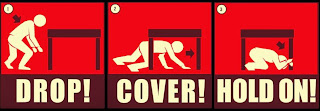Geol9 is exploring the volcanic hazards in different countries and their
warning systems. I’ll be focusing on the US. After learning about tectonic plates, it is not surprise that all our volcanoes are aligned along the 'ring of fire' (except Hawaii as a hot spot).
There
are several ways we minimize the danger of volcanic activity (apart from the
obvious of ‘getting out of the way’…(J:
·
Forecasting (earthquakes as early warnings
-although in 2014 a Japanese volcano erupted without any previous seismicity (livescience
article), land swelling before eruption, gas emissions, etc.)
·
Volcanic
Alert Codes
(USGS): the levels of alert and the aviation code levels commonly change at the
same time (chart on right). A non-erupting volcano will have a green icon, and
a red one indicates an imminent eruption (see USGS Alert Codes).
Today (see image below) the US hazards map shows 5
volcanoes as to be above normal background (elevated unrest):
Cleveland,
Mauna Loa, Pavlof, and Shishaldin Alert Level=ADVISORY. Aviation Color Code=Yellow.
This means: “No eruptive activity detected; minor steaming from summit
crater observed”.
Semisopochnoi Alert Level=WATCH.
Aviation Color Code=Orange. This means: “Elevated seismicity
throughout the week; no eruptive activity observed.”
USGS volcanic hazards 2/22/20
|
The best way to prepare is with education and if you live close to a volcanic mountain, be aware of it, be prepared, and listen to the authorities when evacuation is needed.



